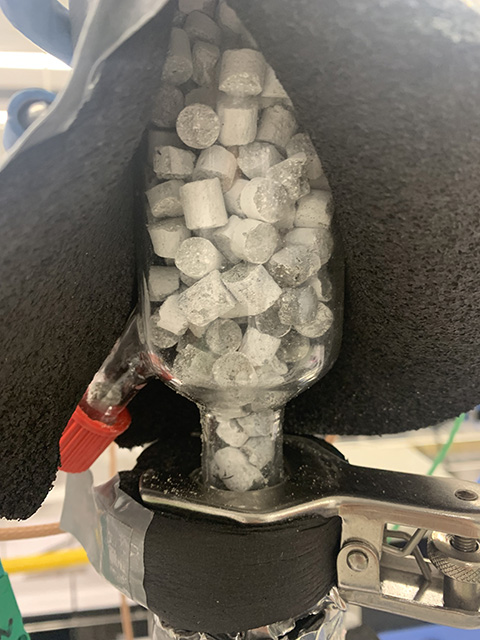
Energy stored in thermochemical materials can effectively heat indoor spaces, particularly in humid regions, according to researchers with the U.S. Department of Energy’s National Renewable Energy Laboratory (NREL), based in Golden.
Working with industry representatives and researchers from Lawrence Berkeley National Laboratory, the scientists determined a practical configuration for integrating thermochemical materials (TCMs) into a building’s HVAC system. Salt-hydrate TCMs are seen as promising candidates for providing flexibility to a building’s heating system, which could reduce electrical requirements or allow for load shifting to times when electricity is less expensive or cleaner.
The TCM is discharged and charged through hydration and dehydration reactions, respectively. Hydrating the salt releases heat, used for heating the building, while extra heat from the heat pump is needed to dehydrate the TCM. This means the reactor must interact with water vapor, which can derive from ambient air in an open system or from evaporating liquid water in a closed system. Open systems are simpler but face challenges in winter due to limited water vapor.
“The way we integrated the reactor into the building, we’re able to do that without drying out the house,” said Jason Woods, a senior research engineer within NREL’s Advanced Building Equipment Research Group and coauthor of the new paper on this topic. “It’s important to think about where the moisture comes from, because performance can be significantly impacted based on how it’s integrated.”
The paper, “Open-cycle thermochemical energy storage for building space heating: Practical system configurations and effective energy density,” appears in the December issue of the journal Applied Energy. Woods’ collaborators include Yi Zeng and Adewale Odukomaiya, both of NREL, along with other co-authors from Lawrence Berkeley and NETenergy LLC.
The research, financed by the Department of Energy’s Building Technologies Office, stems from funding priorities established by the office in 2019 regarding thermal energy storage. As buildings require considerable energy for heating and cooling, thermal energy storage offers an opportunity to shift and shape electrical load, supporting decarbonization by aligning electric heat pump operation with periods of low-carbon energy availability.
The researchers explored the thermal performance of a TCM reactor powered by strontium chloride, which produces heat as it reacts with water vapor. They analyzed various climates and building types, with a focus on the water vapor source. Computer modeling was validated by experimental data, leading to a configuration that allowed the TCM reactor to heat air exiting the building, indirectly warming incoming ventilation via a heat exchanger. This configuration avoids dehumidifying indoor air, maintaining appropriate humidity levels.
Woods stated that the reactor is not intended to replace a heat pump or furnace but to store energy for later use. In modeling, the researchers assumed an indoor temperature of 21 degrees Celsius (69.8 degrees Fahrenheit), with relative humidity as a critical factor affecting reactor performance. They calculated the reactor’s efficacy across four cities: Atlanta, New York, Minneapolis, and Seattle. The reactor performed poorly in Minneapolis due to its colder, drier winters. “There’s little moisture in cold air, so the humidity indoors is lower and it’s more difficult to drive the TCM reaction,” Woods said. Meanwhile, the reactor in Seattle would yield higher thermal performance thanks to more humidity.
Alongside a single-family home, the research evaluated the technology’s effectiveness in a small hotel lobby, a medium-sized office building, and hospital patient rooms. The marginal capital cost for a TCM system decreases as building size increases, with the levelized cost of storage (LCOS) estimated below 10 cents per kilowatt-hour.
The researchers plan to advance this technology. The low LCOS indicates feasible commercialization potential, but further work is necessary to assess reactor manufacturing, integration, packaging, and installation costs to enhance cost-effectiveness. Additionally, they are exploring other ways to integrate TCMs into HVAC systems, including closed-cycle systems that face their own set of challenges.
NREL serves as the U.S. Department of Energy’s primary national laboratory for renewable energy and energy efficiency research and development.


